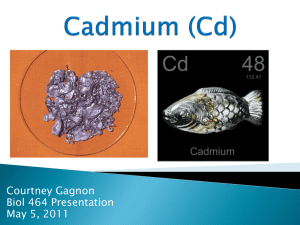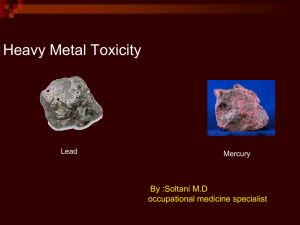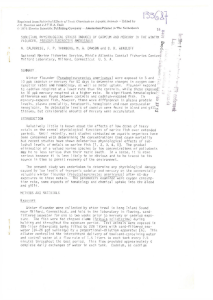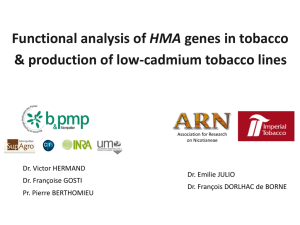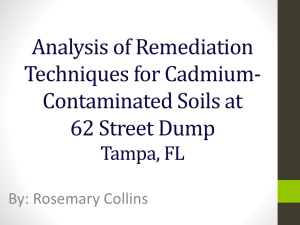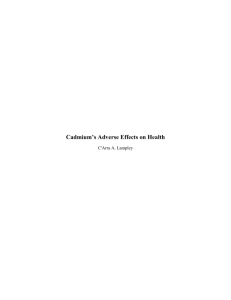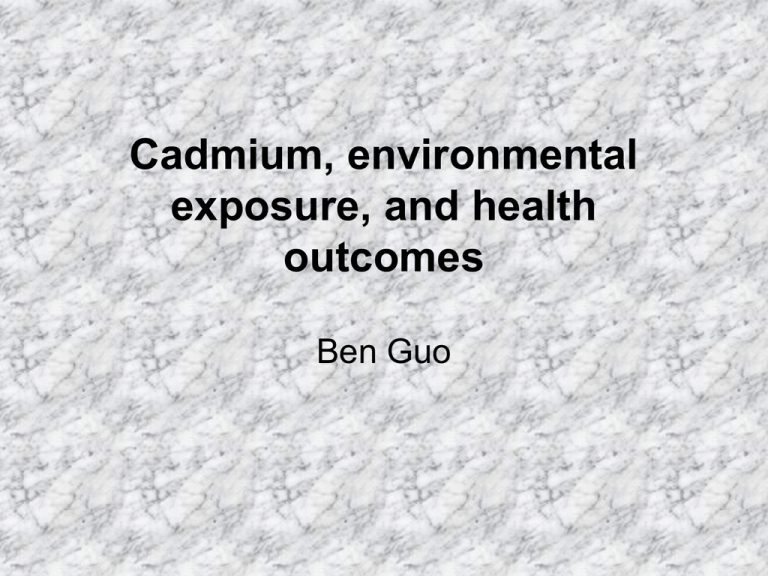
Cadmium, environmental
exposure, and health
outcomes
Ben Guo
Background
• Source: diet (high rate of soil-to-plant
transfer)
• Increased cancer incidence: accumulating
of cadmium
• Kidney is a specific target for cadmium
accumulation.
• Safe intake limit: 7ug cadmium/week/kg
body weight (set based on the critical renal
cadmium concentration between 100-200
ug/g wet weight which corresponds to a
urinary threshold limit of 5-10 ug/g
creatinine)
1.FAO/WHO guidelines for safe
intake
• PTWI: provisional tolerable weekly intake
• PTWI(WHO 1989): 400-500
ug/person/week
• PTWI(WHO 1989): 7 ug/kg body
weight/week
• Renal cortical cadmium 50ug/g wet weight
corresponds to urinary cadmium 2ug/g
creatinine
• However, kidney effects can be observed
at urinary cadmium levels < 0.5 ug/g
creatinine
• Satarug and his colleagues’ studies
suggested that the estimated intake of 2530 ug/day may produce adverse kidney
effects in about 1%of the adult population.
2.Threshold-based models for
safe intake
• Bench-mark dose (BMD): the exposure
level that produces a change in a
response.
• Japanese subjects: BMDL10 of urinary
cadmium is 0.6-1.2 ug/g creatinine in men
and 1.2-3.6 ug/g creatinine in women.
• Swedish women: BMD of urinary cadmium
is 0.6-1.1 ug/g creatinine.
• In a word, the tolerable weekly intake for
cadmium is 2.5 ug/kg body weight, which
corresponds to 25 ug/day for a person
who weighs 70kg.
(European Food Safety Authority 2009)
3.Cadmium sources and
bioavailability
• a. Mollusks and crustaceans
Cadmium in oysters and shellfish is
bioavailable and that long-term oyster
consumption does result in a higher body
burden of cadmium.
• b. Oilseeds
Cadmium in sunflower kernels possess
a high nephrotoxic potential, they may
indicate increased sensitivity to cadmium
renal toxicity in the high sunflower-kernel
consumers.
• c. Offal
In one study, Haswell-Elkins et al. found
high cadmium body burden associated
with higher consumption of turtle liver and
kidney.
Cadmium levels are higher in liver and
kidney than in muscle and older animals.
4.Cadmium exposure and effects
observed
• a. Kidney and bone
1.chronic high- dose effects:
mainly affects women and is
characterized by severely impaired tubular
and glomerular function and generalized
osteomalacia and osteoporosis that result
in multiple bone fractures
•
2.chronic low-dose effects:
has been linked to tubular impairment
with a loss of reabsorptive capacity for
nutrients, vitamins, and minerals.
•
3.current exposure levels
compelling evidence has linked tubular
impairment with urinary calcium loss, rapid
bone demineralization and osteoporosis.
environmental exposure to cadmium
may constitute the risk factors for chronic
kidney diseases.
•
•
•
•
•
•
•
b. Diabetes
c. Diabetic nephropathy
d. Hypertension
e. Lung disease
f. Periodontal tissues disease
g. Ocular tissues disease
h. Cancer: cadmium is classified as a
cancer-causing agent.
5.Cadmium body burden
• a. Sex and tissue differential cadmium
accumulation
Younger individuals have high rates of
renal cadmium accumulation.
There is a trend for higher cadmium
content in the kidneys of the female.
• b. Intestinal absorption of metals, body
burden variability, and metal transporters
The possible intestinal absorption rate
for cadmium is 3-7%.
The people who had low iron stores
usually had higher cadmium body burden.
6.Conclusions
• In the past, the wide variation in cadmium
body burden among people has been
attributed to cigarette smoking and the
high pulmonary absorption rates of
cadmium in cigarette smoke.
• This review concerns about safe intake
level that uses the kidney as the sole
target in assessing the health risk from
ingested cadmium
• The persistence of cadmium in the
environment requires a long-term
approach to minimize human exposure
through environmental management and
maintenance of lower cadmium levels
wherever possible.


